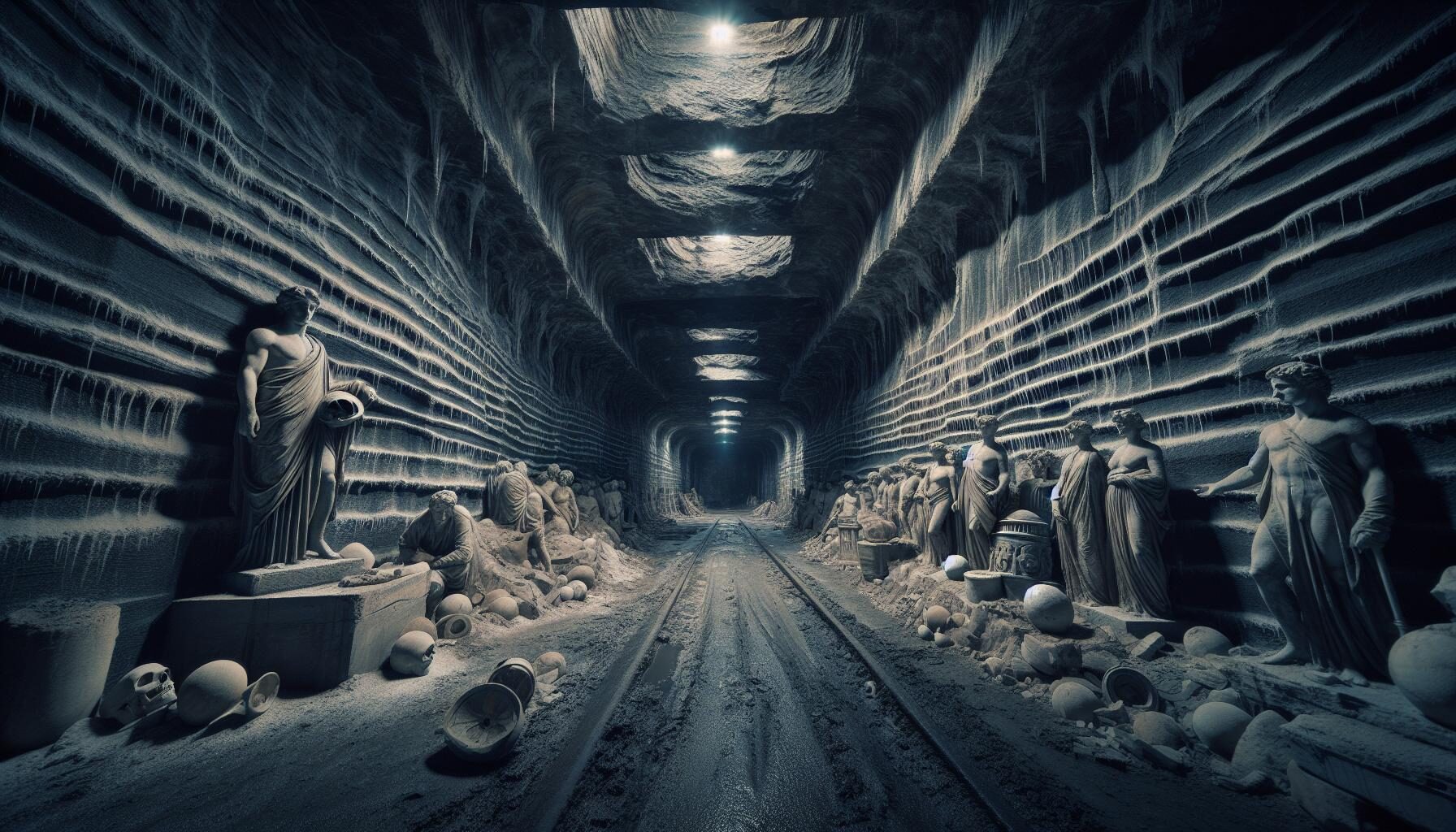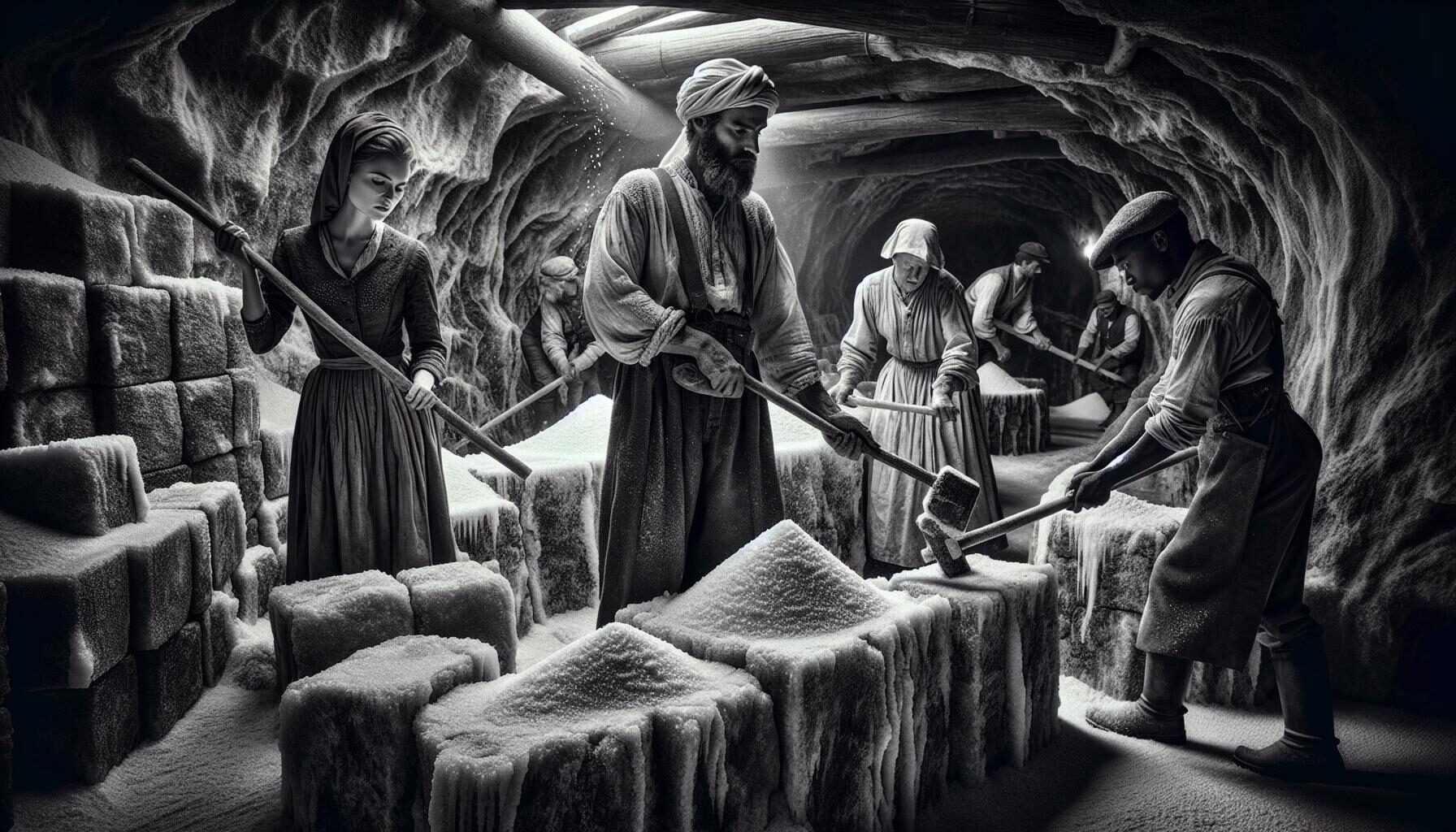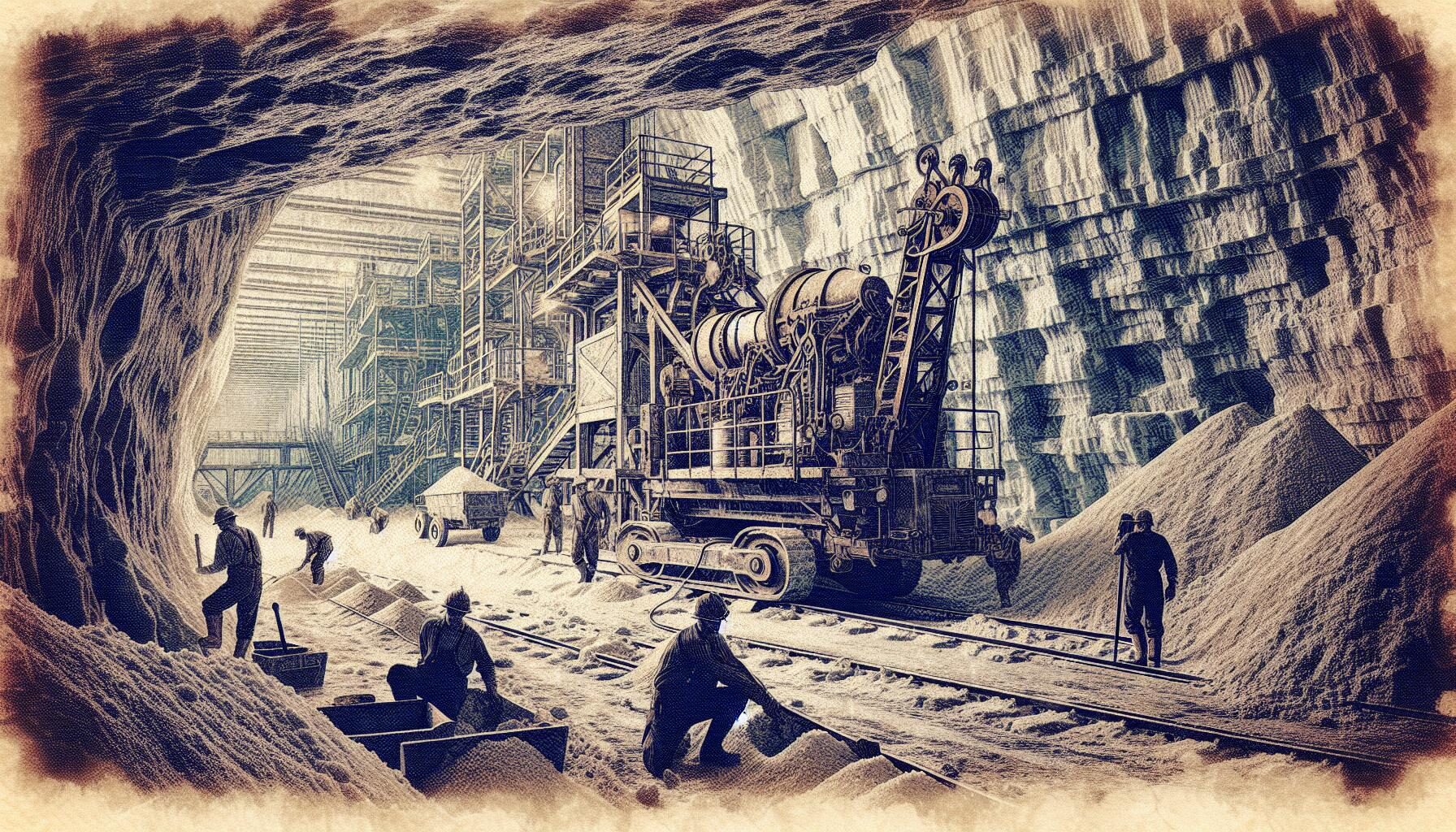Immerse yourself in the fascinating world of salt, deep beneath the earth’s surface at Salzwelten Altaussee. This isn’t just any mine, it’s a journey back in time, unveiling the history of salt mining in the heart of Austria.
We’ll guide you through the labyrinth of tunnels, where miners have been extracting “white gold” for centuries. You’ll learn about the techniques used, the challenges faced, and the vital role salt played in shaping societies. So, let’s strap on our helmets and delve into this subterranean wonder.
History of Salzwelten Altaussee
Stepping into the Salzwelten Altaussee mines is like stepping into a time capsule. It’s a centuries-old tale, interwoven with glimpses of history and a testament to human endeavor. This place is more than a mere salt mine. It’s a museum, a historical site, and an architectural feat showcasing the ingenuity of countless miners etched into the walls.
Established in the year 1517, the Altaussee salt mine distils the essence of Austrians’ relationship with salt, spanning over 500 years. A unique timeline that tells a tale year by year, century by century. Here, layers of earth unveil a storybook of survival, trade, technology and social ties in an authentic setting. Over the years, these tunnels’ challenging contours and the miners’ struggle against nature’s raw elements serve as a monument to human spirit, perseverance, and resourcefulness.
During the Second World War, the mine’s importance transcended the mineral treasures it concealed. Hidden within the labyrinthine patterns of its rooms and passageways, priceless artworks looted by the Nazis were stored safely from the world. The Renaissance masterpieces, including Michelangelo’s Bruges Madonna, were rescued post-war, leaving a poignant tale of historical significance behind the rock salt walls.
Nowadays, the salt mine is a beacon for history buffs, geologists, and family vacationers alike. Offering a surreal journey into the past, the mines showcase spectacular salt sculptures, sound and light shows, a salt lake, and even a miners’ slide, making a visit to Salzwelten Altaussee an unforgettable experience.
As we continue to delve deeper into the intriguing features of this marvelous salt mine, let’s explore the importance of salt throughout history and why it’s often been considered more valuable than gold. With a myriad of uses, salt’s influence is evident in our daily lives, perhaps more than we recognize. From culinary practices to medicinal uses, and its inherent role in trade and economy, we cannot underestimate the pervasive powers of this humble mineral.
Journey through the Salt Mine Tunnels

Venturing deeper into Salzwelten Altaussee, we’ll embark on a journey that caters to our sense of adventure. The clandestine passageways, often cloaked in semi-darkness, introduce us to a world that’s remained largely unchanged for hundreds of years. It’s here in the labyrinthine tunnels that we come into contact with the miners’ work environment – a testament to their dedication, their craftsmanship, and their resilience.
Each tunnel echoes the stories of hardy miners who spent countless days and nights chiseling through mountainous rock. Their persistent efforts have, over centuries, led to a complex network of passageways crisscrossing the mountain’s interior. We can almost feel their spirit resonating around us as we navigate through the dimly lit paths.
Charting our course through the mine, we’ll stumble upon salt sculptures that celebrate the miners’ cultural heritage and symbolize their reverence for salt. Exquisite in design, they lay bare the miners’ artistic prowess and their connection to this valuable resource. It’s not just about business, it’s about life, trade, and continuity that bind people together.
Every so often, we’ll also encounter contraptions and tools reminiscent of historical mining techniques. These remnants serve as a gentle reminder of the evolving technology and the passage of time. It’s fascinating to see how methods have advanced, without losing the essence of mining tradition.
Interwoven with Salzwelten Altaussee’s mining heritage is its role during World War II. The mine served as an impromptu refuge for timeless art pieces, safeguarded from the ravages of war. This seldom-discussed facet of the mine’s history adds a layer of intrigue to our sojourn.
To enhance our experience, the mine also proffers various shows. These presentations amalgamate history, technology, and performance art, offering unique insights into the salt mining process. It all converges into an immersive narrative that’s sure to deepen our understanding of Salzwelten Altaussee’s mining legacy.
With every turn we take within Salzwelten Altaussee, there’s something new to discover about the rich history of salt mining. It’s more than just a tourist attraction. It’s a voyage through time, capturing our collective history right here at the heart of it all.
Extraction Techniques of “White Gold”

As we delve deeper into the salt mining happening at Salzwelten Altaussee, it’s crucial to unveil the techniques employed in extracting this “white gold”. This moniker for salt isn’t just because of its color. Salt’s historic significance as a precious commodity worthy of wars and its central role in food preservation and culinary arts worldwide are some reasons why it’s so titled.
For centuries, miners at Altaussee have toiled in the heart of the mountains to extract this invaluable mineral. Early Mining Methods focused on straightforward, albeit labor-intense drilling and chiseling to excavate the salt deposits. As time progressed, tools and techniques evolved for better efficiency and safety.
Leaching Technique was one notable evolution. Using this process, miners would bore holes in the salt deposit and fill it with water. The water would dissolve the salt to form a brine, which would then be extracted and subjected to the evaporation process to reclaim the salt.
The modern method of Room and Pillar Mining is primarily used now. In this approach, a grid-like pattern is carved into the salt deposit. Large rooms are mined out, leaving pillars of salt behind for structural support. Miners then extract the salt using machinery – a technological leap from their early hand-tool counterparts.
These methods hark back to a time when salt was more than just a seasoning. The effort put into mining mirrors salt’s importance, and visiting Salzwelten Altaussee connects us with history and the sweat of miners past.
As fascinating as the historical perspective is, there’s a layer of technology that adds a modern touch to Salzwelten Altaussee. This blend of ancient heritage and modern day technology takes the story of this ‘White Gold’ to another level, making the mine a memorable educational visit. While the tale doesn’t end here, insights into ‘white gold’s’ extraction techniques help appreciate the legacy it carries.
Challenges Faced by Miners

Venturing deep into the archives of Salzwelten Altaussee, we stumble upon intriguing tales of miners who broke their backs extracting “White Gold.” Life under the surface was an alluring yet challenging expedition for these miners, and despite the high value of salt, their task was not without hardship.
One primary problem was the severe physical strain. Miners chiseled away at rock-hard salt walls for hours on end, sustaining injuries from falling salt crystals, while the glaring rocks strained their eyes. Pre-machinery era mining involved intense exertion, endangering the workers’ health and safety.
Apart from the strenuous physical labor, miners grappled with workplace hazards from fluctuating temperatures and humidity levels in the mine. The lack of ventilation led to poor air quality, creating an atmosphere suffused with dust particles, increasing the risk of respiratory illnesses.
Operating in the intense dark beneath the earth’s surface, miners faced challenges of visibility due to insufficient illumination. This often resulted in mishaps and accidents, making the mining process a dangerous one.
Shifts in the industry, however, brought significant changes that eased the miners’ hardships. The introduction of machinery transformed the labor-intensive drilling routines, taking a huge load off the miners’ shoulders, improving safety while increasing efficiency.
The new era of room and pillar mining was a major breakthrough, offering a structured approach that significantly reduced the risks. This method ensures that parts of the mine are left intact, providing support and reducing the danger of collapsing tunnels.
The leaching technique moved extraction from the physical realm to the chemical one, marking a point of departure from the intense labor required earlier. This method revolutionized the industry, allowing for speedy recovery while lessening the environmental impact.
At Salzwelten Altaussee, the legacy of salt mining isn’t just seen, but felt. The mix of ancient heritage and modern technology leaves visitors with an indelible understanding of the challenges that miners endured and the transformative advancements they embraced in the salt mining process.
Salt’s Role in Shaping Societies
Diving into the history of salt mining, we cannot underestimate salt’s vital role in molding societies throughout the world. Back in ancient times, civilizations realized its value not just for flavoring and preserving food, but also for health and economic purposes.
Our ancestors often settled near salt deposits, giving birth to some of the world’s first major cities. One of the prime examples is the city of Salzburg in Austria, which gets its name from the German word ‘Salz’ meaning ‘Salt’. Its immense wealth stemmed from the profits of the neighboring salt mines, like Salzwelten Altaussee.
Here’s a brief look at how salt shaped economies, wars, and trade routes:
| Factor | Description |
|---|---|
| Economies | The wealth of many cities and states was built on salt due to its high demand in preserving food, enhancing its taste, and medicinal use. |
| Wars | Salt has been a major strategic resource, with control over salt mines and trading routes often leading to conflicts and wars. |
| Trade routes |
The salt trade established major trading routes across continents, notably the famous Salt Road in Europe and the Salt Routes in China.
Transitioning from historical influences to modern practices, the story of salt is still unfolding at Salzwelten Altaussee. We’ve witnessed how technologies like room and pillar mining and the leaching technique have transformed salt mining practices overtime. Today, our efforts continue to push boundaries and seek solutions to improve the safety, efficiency, and ecological footprint of salt mining. Innovations are carried out mindful of the laborious past and the legacy of miners who laid the groundwork of salt mining.
Stepping into the realm of Salzwelten Altaussee, one walks into a theatre depicting mankind’s journey with salt. From hardships faced by early miners, transitioning to mechanical aids, and onto present-day advancements, we’re still weaving the unending saga of salt.
Delving into the Subterranean Wonder
As we descend into Salzwelten Altaussee, we find ourselves entering a world cloaked in mystery and immersed in a rich tapestry of history. An exceptional destination, Salzwelten Altaussee is more than just a Salt Mine; it’s a testament to mankind’s enduring relationship with salt and its central role in shaping civilizations.
This subterranean wonder is a time capsule, each layer unveiling a different story from epochs long past. The salt mine has stood the test of time, marking significant epochs in human history. It’s a world filled with awe-inspiring stalactites, labyrinthine tunnels, and vast salt deposits. These deposits, vast and untapped, excited the imaginations of those who first stumbled upon them. They’ve given rise to a range of innovative mining techniques, such as the room and pillar mining and leaching.
Innovative displays, well-preserved historical artifacts, and state-of-the-art technology immerse visitors in an interactive journey. We experience the life of early miners and empathize with their struggles as we navigate through perilous routes, navigate the challenges they faced, and marvel at their tenacity.
Efforts to enhance safety, efficiency, and sustainability in salt mining are evident, showcasing humanity’s remarkable knack for adaptation. Even as we pay homage to the past, we’re cognizant of the opportunities offered by technology to shape the future of mining. Indeed, the intersection of the past and the future in this subterranean wonder is a sight to behold.
Visitors to Salzwelten Altaussee are immersed in a journey into this subterranean wonder – and into mankind’s deep-rooted relationship with salt. It’s certainly no ordinary excursion; it’s a dive into the heart of history, rolling back the curtain on centuries of human innovation all centered around this ubiquitous yet essential mineral.
As we continue to explore this labyrinth, let’s delve into those efforts to enhance safety, efficiency, and sustainability in salt mining. We’ll understand better how a commitment to continuous improvement keeps the legacy of Salzwelten Altaussee miners alive while catapulting this subterranean wonder into the modern era.
Salt Mining Today

Jumping from historical perspectives, let’s delve into the state of salt mining today. Though centuries have passed since the early days at Salzwelten Altaussee, we’re far from severing our ties with this essential mineral. In fact, our dependency on salt has only grown, opening new avenues for innovation and technology.
The room and pillar mining techniques used at Salzwelten Altaussee have undergone a remarkable transformation. As we strive for better efficiency and safety, contemporary engineering concepts have become integral in this evolution. Advanced machinery and robotics are now streamlining processes that were once labor-intensive. This includes drilling, blasting, crushing, and transporting the material to the surface.
In keeping pace with our bid for environmental sustenance, several mining sites like Salzwelten Altaussee have adopted sustainable practices. One such method is leaching, a method favored for its low surface disturbance and minimal carbon output. This process involves pumping heated water into the salt deposit, dissolving the salt into brine, which is then extracted and evaporated.
Accompanying these advancements is a robust system of safety measures. High-tech equipment is widely used for continuous monitoring, ensuring the well-being of workers. It’s also worth mentioning the role of stringent regulatory bodies in overseeing compliance with safety, health, and environmental norms.
Attention has also shifted towards maximizing the value extraction from Salzwelten Altaussee’s rich salt deposits. Besides the traditional applications in the culinary world, we’ve discovered uses of salt in plastics, textiles, detergents, and even pharmaceuticals.
A visit to Salzwelten Altaussee today not only provides a glimpse into history, but also a forward-thinking approach to exploiting mineral resources responsibly. Cutting-edge technology and mining practices on display underscore the balance between our need for salt and environmental conservation efforts. As mankind’s “white gold”, this essential mineral continues driving our industries and economies, revering the legacy of Salzwelten Altaussee for generations to come.
Conclusion
We’ve journeyed through the intriguing world of salt mining at Salzwelten Altaussee. We’ve seen how technology and sustainable practices are revolutionizing the industry, making it safer and more efficient. We’ve also explored the diverse uses of this essential mineral, stretching far beyond our kitchen tables. A visit to Salzwelten Altaussee isn’t just a trip to a salt mine, it’s an immersion into a legacy that continues to shape our world. It’s a testament to how we can responsibly exploit mineral resources while preserving our environment. So, let’s honor this legacy and continue to value the role of salt in our lives and industries.
What is the current state of salt mining?
The current state of salt mining is continually improving, courtesy of advancements in machinery and robotics. Techniques like room and pillar mining are evolving, and sustainable practices such as leaching are reducing environmental impact. Worker safety and regulatory oversight are also prioritized.
What role does Salzwelten Altaussee play in salt mining?
Salzwelten Altaussee is a significant location in salt mining. It showcases a forward-thinking approach to responsible mineral exploitation. It successfully balances the need for salt production with environmental conservation efforts.
How is the evolution of mining techniques impacting the industry?
The evolution of mining techniques like room and pillar mining is intensifying the efficiency of salt production. By reducing the manual labor involved and optimizing the retrieval process, these advances are significantly impacting the industry.
Is salt important beyond culinary use?
Indeed, salt’s importance extends beyond culinary uses. It plays a pivotal role in multiple industries ranging from healthcare and water treatment to the production of various chemicals, thus driving economies.
How is the well-being of workers ensured in salt mining?
Safety measures and regulatory oversight play pivotal roles in ensuring worker well-being in salt mining. Stricter regulations and state-of-the-art safety equipment reduce potential risks and promote a safe working environment.